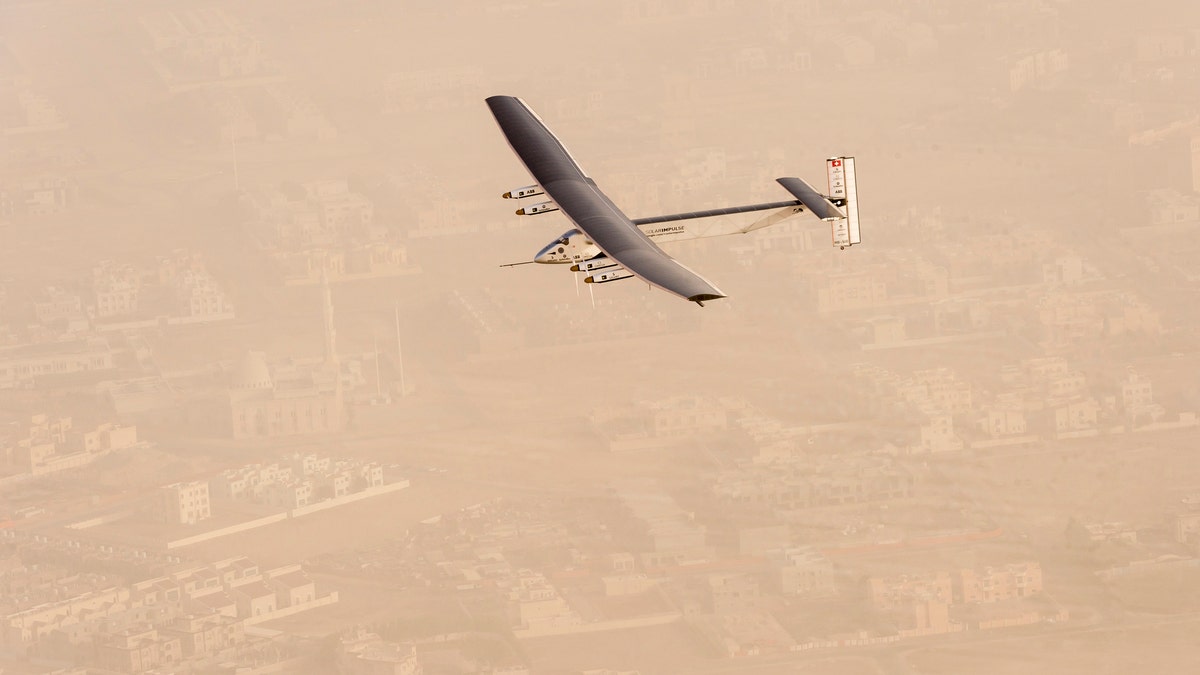
A view of the Solar Impulse 2 on flight after taking off from Al Bateen Airport in United Arab Emirates on March 9, 2015. (REUTERS/Jean Revillard/Handout via Reuters)
The most daunting leg of Solar Impulse 2’s epic journey around the world will be a massive test of endurance for the solar-powered plane’s pilot Andre Borschberg.
The Solar Impulse 2 team is waiting for favorable weather conditions before Borschberg can embark on the grueling 5,079-mile, five-day flight from Nanjing, China, to Hawaii. In addition to the technical challenges of flying the single-seater plane over a vast expanse of Pacific Ocean, Borschberg also will also face huge mental and challenges.
“I have prepared a lot of things – I have done a lot of simulations,” he told FoxNews.com in a phone interview from Nanjing. “I have spent three days and three nights in a simulator – it’s the same physical environment, but it’s not the same emotional environment.”
Nonetheless, Borschberg told FoxNews.com that he is very well prepared mentally. “I visualize the flight constantly,” he explained.
The lightweight plane, a larger version of a single-seat prototype that first flew five years ago, is made of carbon fiber and has 17,248 solar cells built into the wing that supply the plane with renewable energy, via four motors. The solar cells recharge four lithium polymer batteries, which provide power for night flying.
The plane has a 236-foot wingspan, larger than that of the Boeing 747, but, thanks to the lightweight carbon fiber, weighs about as much as a car at around 5,070 pounds.
However, the plane’s cockpit is too small to stand in, although the seat can recline into a horizontal position to allow Borschberg to lie down. “I will use meditation and breathing techniques to calm down and sleep,” he said, adding that he plans to sleep for 20 minutes at a time, up to eight times a day. “20 minutes is the maximum I can allow myself, to allow the airplane to fly by itself – we have a sort of autopilot – it’s a stabilization system.”
Borschberg’s naps, however, will all come at times when Solar Impulse 2 is flying at low altitude. The pilot must wear an oxygen mask at high altitudes in the unpressurized plane.
The aircraft will climb to the altitude of Mount Everest, almost 29,500 feet, during the day to get more sunlight, recharge the batteries and store more energy. At nighttime, the plane will fly lower, at a minimum of 3,000 feet. Borschberg will experience temperatures ranging from 95 degrees Fahrenheit in the morning to minus 4 degrees Fahrenheit early in the evening while the plane is still high up. “Every day we go from a warm summer to a winter day because of the change in altitude,” he said.
Solar Impulse 2 is expected to fly between 30 mph and 60 mph during its journey.
Borschberg will use yoga during the flight to keep his muscles relaxed. His food has been specially developed for the journey, and is capable of withstanding massive fluctuations in temperature. “It looks good and it tastes good,” he said. “I can eat risotto, the next day I can eat chicken and vegetables.”
During the flight Borschberg will eat about 2.2 lbs of food and drink up to 4 liters of water a day. When nature calls, he will use a toilet built into the plane’s seat.
An entrepreneur who flew military jets for 25 years as a reserve pilot in the Swiss army, Borschberg is looking forward to making the daunting journey across the Pacific ocean.
“If you ask me how I feel, I feel very confident,” he said. “I am very excited – it’s a dream that I have had for a very long time that I can realize now.”
Borschberg and his fellow Swiss pilot Bertrand Piccard are taking it in turns to fly the solar-powered aircraft on its five-month journey across the globe. Solar Impulse 2 set off from Abu Dhabi in March, and has stopped in Oman, India, and Myanmar en route to its latest stop in Nanjing, China.
The latest leg of the journey, however, is the biggest challenge that the Solar Impulse 2 team has faced so far. While none of the previous legs were more than 20 hours, the estimated flight time to Hawaii, is 120 hours.
After Hawaii, the second Pacific leg of the journey will take the plane to Phoenix. Solar Impulse 2 is slated to stop in New York, possibly around mid-June, before flying over the Atlantic Ocean. It will then stop in southern Europe or North Africa, depending on weather conditions
The Associated Press contributed to this report.
Follow James Rogers on Twitter @jamesjrogers
